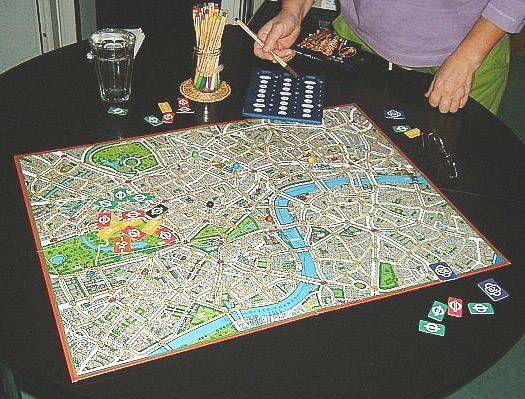Players 3–6 Setup time 5–15 minutes | Age range 10+ Random chance initial set-up | |
 | ||
Playing time Skill(s) required Tactics, Strategy, and Bluffing | ||
Scotland Yard is a board game in which a team of players, as police, cooperate to track down a player controlling a criminal around a board representing the streets of London. It is named after Scotland Yard, the headquarters of London's Metropolitan Police Service. Scotland Yard is an asymmetric board game, with the detective players cooperatively solving a variant of the pursuit-evasion problem. The game is published by Ravensburger in most of Europe and Canada and by Milton Bradley in the United States. It received the Spiel des Jahres (Game of the Year) award in 1983. A sequel to Scotland Yard was released called "Mister X".
Contents
Gameplay
One player controls "Mr. X", a criminal whose location is only revealed periodically, and the other players each control a detective, which is always present on the board.
All players start with a number of tokens allowing them to use the following methods of transport:
Each player (Mr. X and the detectives) draws one of 18 possible cards which show where a player has to start, with Mr. X always drawing first. The locations on these cards are spaced far enough apart to ensure that Mr. X cannot be caught in the first round of play. There are a total of 199 locations on the board.
Each detective begins with a total of 22 tokens. Once each transport token is used by a detective, it is turned over to Mr. X, effectively giving him unlimited transport. As he makes each move, he writes down his destination (either in the log book provided with the game, or on a sheet of paper) and covers it with the token he has used, so that the detectives have clues as to his whereabouts. Mr. X also has a supply of black tokens that can be used for any mode of transport (one per detective in play; in the Milton Bradley version this is always five), and two cards that allow him to make two moves in a single turn. The water routes require a black token; when one of these is played, the detectives must consider whether or not it is being used to hide a river trip. Mr. X moves first on every turn, after which the detectives must move in the same order.
At five specific times during the game, Mr. X has to reveal his current position. Detectives will take this opportunity to refine their search and, if possible, plan ways to encircle him. From each known position, the types of transport used by Mr. X limit the number of possible locations he can reach on his next move, which provides useful information to detectives (as well as preventing some types of cheating by the fugitive player).
The game is won by the detectives if any of them lands on Mr. X's current location or vice versa. Mr. X wins by avoiding capture until all detectives can no longer move, due to either exhausting their token supplies or reaching a space for which they have no more usable tokens.
Although the game says it is for 3-6 players many play this game with only 2 players. The police, when controlled by 1 person, are far more coordinated and have a better chance of catching Mr. X. When 3-5 people are playing as the police they have to work as a team and coordinate their moves which can be difficult, especially when one player wants to play a hunch.
The contents of the game contain:
There are two main board editions, one typically associated with Milton Bradley, and another typically associated with Ravensburger. The primary difference between these is in the numbering of the stations: five stations are numbered differently, with 108 missing from the Milton Bradley boards, and 200 missing from the Ravensburger boards. There are also minor differences in the routes, such as a bus line between stations 198 and 199 that is changed to a taxi line in later editions, and the removal of a taxi line between stations 13 and 14 sometime after the renumbering.
Alternative versions
The game has been adapted to take place on maps of different cities. Scotland Yard Tokyo, also distributed by Ravensburger, takes place on the streets of Tokyo, with the major difference being game aesthetics. Scotland Yard: Swiss Edition uses the same gameplay and is set in Switzerland, with the addition of more boat routes and ski areas available only to Mr. X.
NY Chase is a version based on New York City. In this version, detectives do not hand their used tokens over, and they have access to roadblocks and a helicopter, tilting the game more in favour of those playing as detectives.
A faster travel version called Die Jagd Nach Mister X exists that functions quite differently. In this version, Mr. X's location is only hidden when a black travel token is used, and the game is essentially an open chase around London. Evasion is accomplished with black tokens and using the fastest travel to distant locations. In this version, each player takes turns as Mr. X, and points collected (in the form of the detectives' used travel tokens) determine the overall winner.
Alternative rules
Three years after the game's publication, Alain Munoz and Serge Laget posted an article in the French magazine Jeux & Stratégie suggesting alternative rules to balance and expand the game.
